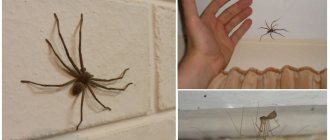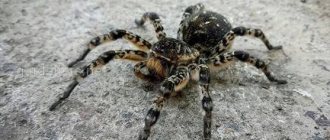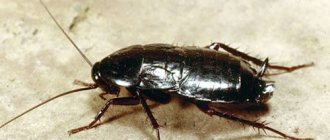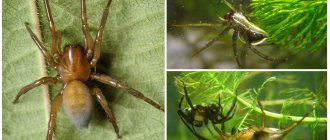Granola Bionova Nutty, crispy, baked, 400 g
358 ₽ More details
Granola Bionova Chocolate, crispy, baked, 400 g
318 ₽ More details
Shimmers
There are many different spiders in nature, but some of them settle in a house near a person. Due to popular superstitions, some people prefer not to touch their new neighbors, others dislike them and are afraid of being bitten, so they try to drive out or kill the spiders. But in fact, house spiders are not so dangerous and sometimes even beneficial.
House spiders can come in different sizes and have different external characteristics.
Types of house spiders
All spiders belong to the arthropod family and are predators. They are found on different continents with the exception of Antarctica. Arthropods feed on insects and small animals. Of the 42 thousand species of spiders, only 10 are capable of living at home. It is difficult to notice them, since they love dark corners, and when they see a person they immediately hide. Species of spiders in the home are recognized by the appearance of the arthropod and the type of web. The most common of them:
- centipedes;
- gray;
- black;
- white;
- tramps;
- jumper.
The gray and black house spiders love warm places and do not leave them. These small arthropods, no more than 15 mm in size, weave small webs in the form of a tube. This is mainly done by females.
House spiders in the CIS countries can be dangerous only in regions in the south with a warm climate.
White spiders can be found in any country. They rarely come into the house, as they prefer nature. They live in forests, gardens and vegetable gardens. Of all arthropods, these are the most dangerous. A person can die from their bite. The white "flower spider" is found in North America, Japan and Russia. An arthropod called the “white lady” lives in Africa. The climate of southern Russia and the Middle East is suitable for karakut.
Centipedes are window spiders that live in the corners of the window sill. They are also called haymakers. The centipede has a small, round, dark-colored body and 8 long, thin legs. Their length reaches 5 cm, and they are the ones that are most noticeable. The body of black spiders is covered with small hairs. Some of them have yellow designs. Arthropods have two pairs of eyes, but they navigate by their senses. The web turns out to be chaotic, since it is constantly being rewoven after the insect has been eaten. To prevent large insects from getting caught in the web, the spider swings the web.
This video details how to keep exotic spiders at home:
The hobo spider does not like to sit in one place and constantly changes its home. Such a predator does not weave a web; it jumps onto its prey and paralyzes it with poison. This is a large species with an elongated abdomen of brown or light brown color. Its legs are long with a span of up to 5 centimeters.
The jumper is an unusual species that likes to settle in the house. The color of the jumping arthropod is varied, the abdomen is decorated with a pattern. The paws are covered with small hairs and claws. Thanks to this, the little creature jumps and moves easily on the glass. The horse has eight eyes arranged in 3 rows. It feeds on acacias, so it is not considered a predator.
Read on topic:
Where are funnel-web spiders found and are they dangerous?
14.11.2020
Why signs of arachnophobia appear and what to do about it
14.11.2020
The most popular types of Australian spiders
14.11.2020
The appearance of a tarantula and the consequences of a spider bite
03.07.2019
One of the most interesting and beautiful species of house spiders. Completely harmless
All types of house spiders feed on the same principle. When insects (bugs, midges, flies) fall into the web, the spider injects them with poison. The insect's insides dissolve and the predator eats them. Apartment spiders live from 2 to 6 months and reproduce in small numbers. Due to lack of food, offspring appear late.
How does a spider kill its victims?
Arachnids differ somewhat in their lifestyle, behavior, and hunting tactics.
- Animals weave trapping nets and wait for their prey in the center of their creation or in the immediate vicinity. The presence of insects is determined by vibrations.
- They actively search for a victim, exploring the surrounding area. They attack at the right moment.
- Some spiders do not weave trapping webs, but construct the web in the form of a funnel near the burrow or shelter.
Food for spiders
Predators also behave differently - they entangle prey with their threads, leave them for a while, and begin to feed on insects almost instantly. However, initially predators act identically with their victims - they inject a toxic substance.
All spiders have poisonous glands; they kill insects and small vertebrates with chelicerae, which are located in front of the cephalothorax in the form of fangs. A poison with a paralyzing effect, one’s own saliva, is injected into the wound, which turns the insides into a liquid mass.
On a note!
It takes 5 to 15 minutes for the prey to become usable. All this time, the predator watches the insects, sitting to the side. When the body stops convulsing, the meal begins.
Reasons for appearance
Food is the main reason why arthropods take up residence in a home. But besides food, there are a number of other reasons:
- With the arrival of cold weather, some predators move into the house, as it is warmer there.
- The choice of location is influenced by air humidity. Those spiders that prefer cold and damp places can be found in the basement and bathroom. The kitchen and bedroom are inhabited by heat-loving species.
Many factors contribute to the appearance of spiders - Arthropods love rooms that are rarely cleaned. In such places there is a lot of food and there is an opportunity to actively reproduce.
Most often, predators enter a home with wildflowers, outdoor clothing, and through open windows and doors. If environmental conditions allow them to live in a house, then they stay in it for a long time. If there is not enough food or there is no food at all, then they look for a new place.
Exotic in the house
Connoisseurs of exotics keep some species as pets. The most popular of them are tarantulas. This is a calm species of predators that, with proper care, gets along well with humans:
- White-haired. This type of arthropod is safe for humans, but in a hungry state the predator is capable of biting the owner. The body of the tarantula is 7 cm, the paw span is 16 cm. Unlike females, who can live for about 12 years, the lifespan of a male is no more than 3 years.
- Two-color. When purchasing a bicolor tarantula as a pet, you need to be very careful, as its bite causes an allergic reaction. It feeds on large insects. The lifespan of a female is about 20 years, a male - no more than 4 years.
- Giant. This exotic tarantula comes from Brazil. The female eats the male immediately after mating, and she continues to live for about 12 years. A giant species: its body is 10 cm long, its paw span is 25 cm.
Frequent guest in the homes of people who are in tropical countries - Horned. People who have never dealt with spiders should not buy a horned tarantula. This is a very dangerous predator with a capricious character. It hunts at night and can bite. The horn located on the head will help to recognize the tarantula among other arthropods.
- Striped. This is a large tarantula, about 10 cm or more in length. The paw span is 20 cm. The predator eats a lot, so you will have to feed it 2 times a week. It feeds on beetle larvae, cockroaches and crickets.
Danger to humans
Are house spiders dangerous for humans if they take up residence in a house? Small species that enter the house from the street are not dangerous to humans, since they do not emit poison. But if you don’t take action, they will begin to weave cobwebs into the corners of rooms and actively multiply. Arthropods rarely attack humans, but, sensing danger, they can sting. Despite the fact that they are not poisonous, when bitten, a secretion is released from the mouth, which can cause an allergic reaction. In areas with hot climates, black strays are especially dangerous. It is enough to treat the bitten area with an antiseptic.
Signs about spiders in the apartment
There are many folk omens associated with these insects. Since ancient times, people have observed house spiders and, based on their behavior, predicted important events that awaited the family.
- If the spider crawls down, expect trouble. It’s much better if it creeps up - it’s for profit;
- Seeing a spider in the morning portends bad news, in the evenings, on the contrary, good luck;
- A large number of cobwebs under the bed for unmarried people is a promise of new love. On the other hand, a married couple should be more attentive to each other's wishes;
- If a spider is found near money, expect unexpected financial benefits;
- The luckiest spider is white. The color black is considered a bad omen and brings bad luck.
Not everyone believes in omens these days, but there is one thing that even scientists agree on - you can’t kill spiders! And not because it will bring unhappiness into your life. They are simply an integral part of the apartment (house) ecosystem. Small domestic arthropods are not dangerous to humans. However, they do catch harmful and unpleasant insects such as mosquitoes and flies. This is how spiders make our lives better.
If a spider causes you inconvenience and you are afraid of it, do not kill it, just take it outside the apartment or house.
Methods of disposal
There are many ways you can get rid of spiders. The simplest is cleanliness of the room and destruction of food:
- First, all small insects are exterminated - flies, cockroaches and bedbugs.
- Use a broom or vacuum cleaner to remove all cobwebs. If a vacuum cleaner was used for cleaning, then the bag is immediately taken outside and cleaned, otherwise the spider will crawl out and begin to weave a new web.
Cleaning cobwebs and searching the apartment for spider nests will help get rid of arthropods - A large number of arthropods means that there are clutches of eggs somewhere. Most often they are found in closed places, for example, on the back walls of furniture. All surfaces on which spiders moved are cleaned with household chemicals or paint. Since they cannot tolerate strong odors, this will help get rid of them.
- There will be fewer arthropods and they will disappear altogether if you place bottles with essential oils of eucalyptus, mint or vinegar in the corners. They also cannot tolerate the smell of citrus and chestnut fruits.
- Special chemical fungicides will help with large concentrations of spiders. Among the substances it is worth choosing those that contain pyrethroids.
Regular cleaning of the house and constant cleanliness are good prevention against arthropods. Mosquito nets placed on the windows and grilles on the ventilation hood will prevent their occurrence. A room is unsanitary if there are too many spiders in it.
Folk signs
There are many signs and superstitions associated with spiders. Therefore, before killing them, many people wonder whether it is worth doing it or not. The signs read:
- Success and prosperity will come in the near future.
- If an arthropod descends along a web, then you can expect guests or an unexpected letter.
There are many beliefs about the appearance of spiders in the house, whether to believe in them or not is everyone’s choice - If he moves along the floor or runs towards the table, he is moving.
- Fell on your head or hand - monetary gain is expected.
- A cobweb over the bed means illness and problems in the family.
It is believed that killing a spider will cause bad luck and trouble. But breeding them in the house, overgrown with cobwebs, is also not a solution. In order not to kill arthropods, it is enough to catch them and throw them outside.
What do spider bites look like?
Spider bites are different and have their own specific appearance. What to do if you are bitten by a spider at home, on the street or in the forest:
- Determine the type of individual.
- Treat the bite site.
- Go to the hospital.
Each arthropod has its own characteristic bite. Let's look at what a spider bite actually looks like below.
Cross
The bite of the cross spider is almost harmless, except for the feeling of discomfort in the affected area. The poison used by the predator is low in concentration and is not capable of paralyzing or killing a person. A spider bite looks like a white spot edged with a red ring.











